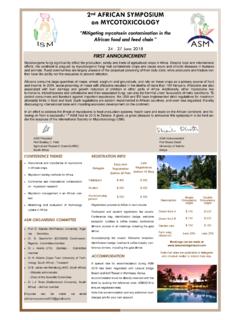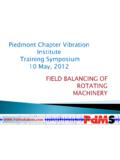Transcription of WHY IS TYPE S HYDRATED LIME SPECIAL?
1 International Building Lime symposium 2005. Orlando, Florida, March 9 -11, 2005. WHY IS TYPE S HYDRATED LIME special ? . Margaret L. Thomson 1. Abstract Type S HYDRATED lime is defined by high early plasticity, high water-retention values, limited oxide content, and minimal coarse fraction. These qualities are highly valued for plaster and mortar. At the turn of the 19th Century in the United States, lime calcined from dolomitic limestone in Ohio was recognized as the best lime for interior plaster use. Starting about 1910, The American National Bureau of Standards, in collaboration with The National Lime Association and other masonry material producers, started what was to become a 30-year effort to characterize the nature of HYDRATED lime for building construction.
2 They developed most of the methods of testing and definitions of key properties used in today's specifications. Commercial awareness of the value of producing a HYDRATED lime that would achieve all these properties in a reproducible manner led to two patented technologies that are used today. No other lime industry or standards development organization in the world has looked at HYDRATED lime in the same manner. The original characterization effort plays a continued important role in both the plaster and mortar industries of today. Key-Words Emley plasticity, workability, lime, type S HYDRATED lime, finishing lime, masonry mortar, plaster.
3 Copyright NLA Building Lime Group 2005. The views presented in this paper are solely those of the authors. The National Lime Association (NLA) and the Building Lime Group assume no liability or responsibility for any errors, omissions, or other limitations in this paper or for any products, services, or methods presented. This paper is intended for use by professional personnel competent to evaluate the significance and limitations of the information provided and who will accept full responsibility for the application of this information. NLA and the Building Lime Group do not intend to infringe on any patent or other intellectual property right or induce any other party to do so, and thus users of this document are responsible for determining whether any method, technique, or technology described herein is protected by patent or other legal restriction.
4 1. , Technical Manager, National Building Construction, Chemical Lime Company, 1 Introduction The S in Type S HYDRATED lime, as defined by ASTM C 206 and ASTM C 207, was coined because the HYDRATED lime was considered to be special . Its special qualities include high early plasticity, high water-retentivity values, limited oxide content, and minimal coarse fraction. These properties enhance the performance of both mortar and plaster. The same descriptor and emphasis on plasticity and water retentivity do not occur in any other national standard HYDRATED lime specification. Other national standard HYDRATED lime specifications describe HYDRATED lime for building construction by their chemical composition (Tate, 2005 [this volume], eg.)
5 EN 459-01 Building Lime Part 1: Definitions, Specifications and Conformity Criteria). In the today's plaster and masonry industries in the United States, Type S HYDRATED lime is used almost exclusively. In 1977 in the United States, no more than 2% of the building market used pulverized quicklime (Boynton, 1980) and the remaining 98% used HYDRATED lime. Of the 98% that used HYDRATED lime, over 95% are estimated to have used Type S HYDRATED lime. These values are not much different today. Unlike other nations at the same stage of industrial development, HYDRATED lime remains a significant material in the United States building construction industry.
6 For many countries in Western Europe, use of lime in building construction is limited to restoration of medieval castles; and is not used for building new masonry buildings and their rendering. The objectives of this paper are: to explore the historical development of Type S HYDRATED lime in the United States;. to review the technical implications of that development; and to review the economic implications of that development. 2 Commercial impetus for development of Type S HYDRATED lime The roots of Type S HYDRATED lime are bedded in the interior plaster industry. At the end of the 19th Century in Europe and America, most interior walls of houses and offices were plastered (Millar, 1897).
7 The finish coat of the plastering job is the most demanding of material, craftsman, and budget. Cowper (1927) observes that: Lime used in plaster-work is generally slaked with an excess of water to form a putty, and this putty is then stored in a covered pit or trough until used. Practically all authorities, both ancient and modern, are unanimous in demanding an adequate length of storage time for tempering this slaked lime before it is actually used (p 30). He goes on to say, Whilst it is hardly practical at the present time to afford always so long a time as the traditional three months or a year for the tempering process, it is evident, that for good permanent plaster-work great care should be taken in slaking to avoid unslaked particles of appreciable size, and to remove any over burnt residues; a reasonable time should also be allowed between slaking and actual use.
8 With mechanically HYDRATED lime, particularly if stored dry some time, and made into putty the day before use, the danger of the presence of large, unslaked particles is very small. (p 31). Lime putty was progressively being displaced by HYDRATED lime, which was more convenient and already slaked (Lovewell, 1975). For commercial use, quicklime slaked to HYDRATED lime was more attractive than quicklime slaked to lime putty. Transporting water was and is expensive. However, quicklime slaked directly to lime putty and stored for an appropriate length of time (not defined), would produce a more plastic lime than quicklime slaked to HYDRATED lime and then to a putty, with one exception: Ohio finishing lime.
9 Ohio finishing lime, which was dolomitic quicklime slaked to HYDRATED lime and then wetted to a putty and stored for twenty-four hours, was considered as plastic Page 2. as quicklime slaked directly to a putty. There were probably 20 producers or more at the time, working one regionally-extensive geologic unit: the Lockport (Dolomite) Formation of the Niagara Group, which is middle Silurian in age. Emley (1920) indicates that Ohio finishing lime commanded as much as $26/ton and was transported as far as Los Angeles in 1915. Ohio finishing lime was prized for its white color and high plasticity.
10 Like anything profitable, there was considerable interest in making Ohio finishing lime more readily available by making the process more efficient. In 1918, Charles and Irving Warner of Willmington, Delaware submitted a patent titled Method of Hydrating Dolomitic or Magnesian Lime , which states: Our invention relates to a process of hydrating dolomitic or magnesian quick-lime and has for its object to secure, as far as possible, the hydration of a material or part or all of the magnesium oxide, in addition to the hydration of all the calcium oxide in order to secure additional strength in mortars made from such HYDRATED limes.





